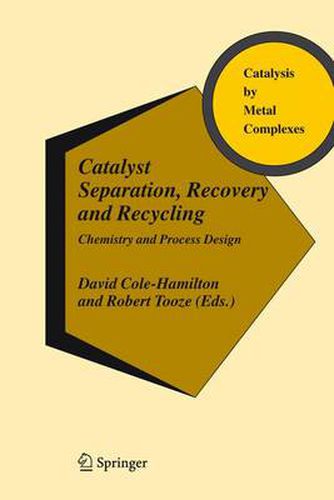Readings Newsletter
Become a Readings Member to make your shopping experience even easier.
Sign in or sign up for free!
You’re not far away from qualifying for FREE standard shipping within Australia
You’ve qualified for FREE standard shipping within Australia
The cart is loading…






This title is printed to order. This book may have been self-published. If so, we cannot guarantee the quality of the content. In the main most books will have gone through the editing process however some may not. We therefore suggest that you be aware of this before ordering this book. If in doubt check either the author or publisher’s details as we are unable to accept any returns unless they are faulty. Please contact us if you have any questions.
This book looks at new ways of tackling the problem of separating reaction products from homogeneous catalytic solutions. The new processes involve low leaching supported catalysts, soluble supports such as polymers and dendrimers and unusual solvents such as water, fluorinated organics, ionic liquids and supercritical fluids. The advantages of the different possibilities are discussed alongside suggestions for further research that will be required for commercialisation. Unlike other books, in addition to the chemistry involved, the book looks at the process design that would be required to bring the new approaches to fruition. Comparisons are given with existing processes that have already been successfully applied and examples are given where these approaches are not suitable. The book includes:
New processes for the separation of products from solutions containing homogeneous catalysts
Catalysts on insoluble or soluble supports - fixed bed catalysts - continuous flow or ultrafiltration
Biphasic systems: water - organic, fluorous - organic, ionic liquid - organic, supercritical fluids (monophasic or biphasic with water, organic or ionic liquid)
Comparisons with current processes involving atmospheric or low temperature distillation
Consideration of Chemistry and Process Design
Advantages and disadvantages of each process exposed
Consideration of what else is need for commercialisation
$9.00 standard shipping within Australia
FREE standard shipping within Australia for orders over $100.00
Express & International shipping calculated at checkout
This title is printed to order. This book may have been self-published. If so, we cannot guarantee the quality of the content. In the main most books will have gone through the editing process however some may not. We therefore suggest that you be aware of this before ordering this book. If in doubt check either the author or publisher’s details as we are unable to accept any returns unless they are faulty. Please contact us if you have any questions.
This book looks at new ways of tackling the problem of separating reaction products from homogeneous catalytic solutions. The new processes involve low leaching supported catalysts, soluble supports such as polymers and dendrimers and unusual solvents such as water, fluorinated organics, ionic liquids and supercritical fluids. The advantages of the different possibilities are discussed alongside suggestions for further research that will be required for commercialisation. Unlike other books, in addition to the chemistry involved, the book looks at the process design that would be required to bring the new approaches to fruition. Comparisons are given with existing processes that have already been successfully applied and examples are given where these approaches are not suitable. The book includes:
New processes for the separation of products from solutions containing homogeneous catalysts
Catalysts on insoluble or soluble supports - fixed bed catalysts - continuous flow or ultrafiltration
Biphasic systems: water - organic, fluorous - organic, ionic liquid - organic, supercritical fluids (monophasic or biphasic with water, organic or ionic liquid)
Comparisons with current processes involving atmospheric or low temperature distillation
Consideration of Chemistry and Process Design
Advantages and disadvantages of each process exposed
Consideration of what else is need for commercialisation